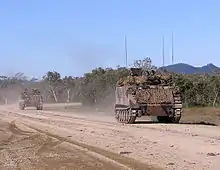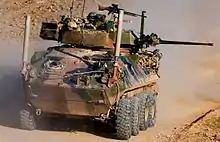Project Waler
Project Waler was an unsuccessful Australian defence procurement exercise which sought to replace the Australian Army's M113 armoured personnel carriers with new armoured fighting vehicles. It was initiated in October 1980 and cancelled in July 1985 due to government concerns over the cost and capabilities of the proposed vehicles. The M113s were upgraded instead, though some were replaced by ASLAV wheeled armoured fighting vehicles that were similar to the designs considered under Project Waler.
History

Project Waler was initiated by the Australian Army in October 1980.[1] The project was named after the Waler horses that had been used by the Army.[2]
The goal of the project was to replace the Army's M113 armored personnel carriers with new armoured vehicles by the mid-1990s. Between 500 and 1,000 armoured fighting vehicles (AFVs) were to be procured, with the Army considering both wheeled and tracked armoured vehicles.[1] It was also intended that the project would provide new opportunities to Australian industry.[3] Studies undertaken by the Australian Department of Defence concluded that the Australian defence industry was capable of designing and producing the vehicles as long as some technologies were transferred from overseas.[4] Project Waler was identified in the early 1980s as being one of three major defence procurement exercises where Australia and New Zealand could collaborate. The New Zealand Army is believed to have held discussions with the Australian Army regarding joining the project in order to replace its M113s.[5]
The first phase of the project began in September 1981, with companies being asked to submit four designs each for different wheeled and armoured vehicles. The proposals also needed to cover how the vehicles would be built and maintained in Australia, and provide an estimate of the expected costs. Australian firms were required to be the lead contractor, but could partner with foreign firms.[2][4][6] At that time it was hoped that the vehicles selected by the Army could also be sold for export.[7] A total of 14 companies submitted proposals by the time this stage of the project closed in February 1982. Three proposals were selected for further consideration in July that year.[6]
During the second stage of the project, the three companies were funded to conduct further studies to "provide the Army with information upon which to base realistic vehicle requirements" and consider the extent of Australian content in the vehicles. The studies would include further consideration of whether the vehicles should be tracked or wheeled, and what engines and armament should be fitted. It was planned that the subsequent stage of the project would involve a tender seeking formal proposals to design and build the new vehicles.[8] This scoping work was completed in early 1983.[3] In December 1983 the Australian Minister for Defence announced that the studies conducted by the three companies had confirmed that it would be feasible to build the vehicles in Australia. At this time it was expected that tenders for the project definition stage of the process would be advertised in August 1984.[4]
Project Waler was cancelled in July 1985, with the government deciding to upgrade the M113 fleet instead. Minister for Defence Kim Beazley stated that while the designs under consideration for Project Waler would have been superior to the M113, they would be very costly to procure.[9] Beazley also noted in his media release that the cost of the project had doubled in real terms since it began.[10] The Canberra Times reported that it had proven difficult to tailor the designs to Australian conditions, and that the government regarded them as unsuited to Australia's needs.[9] The analyst Stanley S. Schaetzel has also suggested that the Army may have not been fully committed to the project and greatly under-estimated its cost, and was surprised by the estimates of actual costs provided during the scoping work.[11]
The federal opposition criticised the decision to cancel Project Waler, which had been initiated while it was in office, arguing that the M113s were obsolete and in poor repair.[12] During a parliamentary question time session in May 1986, Beazley claimed that the requirements which had been set for the Project Waler vehicles were unsuited to Australia's needs. He gave the expected weight of the vehicles' armour preventing them from being carried by the RAAF's C-130 Hercules transport aircraft and the project documents requiring that they have the "capacity ... to keep going for a period of one hour after a nuclear attack on the battlefield with a loss of half its crew" as examples.[13]
Following the project's cancellation the partnerships between Australian and foreign firms which had been established to prepare proposals were dissolved.[14]
Aftermath

In 1987 the Government decided to procure wheeled armoured fighting vehicles to replace the 2nd Cavalry Regiment's M113s; The Canberra Times noted that these vehicles would be similar to those considered under Project Waler.[15] The ASLAV was selected for this role, and was phased into service between 1995 and 1996.[16]
Planning for the M113 upgrade project began in the early 1990s.[17] The government approved the project in November 1993.[18] The upgrade project was protracted, and the first upgraded M113s were accepted by the Australian Army in November 2007.[19] Some of the metallurgical research which was undertaken as part of Project Waler was drawn on for the upgrades to the M113s' armour.[20] Tenders were sought for infantry fighting vehicle designs to replace the M113s in 2018, and a decision on the type to be procured is scheduled to be made in 2022.[21][22]
Project Waler is sometimes cited as an example of the mismanagement of Australian defence procurement projects.[23] Schaetzel argued that Project Waler was, like the Australian light destroyer project, an example of the Australian Defence Organisation initiating an over-ambitious and speculative project that ended in a "fiasco". He also stated that the failure of these projects may have discouraged firms from entering bids for subsequent Defence procurement exercises given the costs involved in preparing proposals.[11]
References
Citations
- Handel 1998, p. 59.
- Department of Defence (29 September 1981). "Tenders Called for First Stage of Project Waler". Media release. Parliament of Australia. Retrieved 26 January 2021.
- Schaetzel 1986, p. 17.
- Foss 1985, p. 240.
- Jennings 1987, pp. 93, 154.
- Handel 1998, p. 60.
- Stackhouse, John (7 July 1981). "Advance Australia Where?". The Bulletin, Defence 81 supplement. p. 61. Retrieved 26 January 2021.
- Department of Defence (14 July 1982). "Project Waler contract negotiations to commence". Media release. Parliament of Australia.
- Cranston, Frank (25 July 1985). "Plans for new army vehicles deferred". The Canberra Times. p. 9. Retrieved 21 September 2019 – via National Library of Australia.
- Beazley, Kim (25 July 1985). "Project Waler". News release. Parliament of Australia. Retrieved 26 January 2021.
- Schaetzel 1986, p. 18.
- "Ministerial statement". Hansard. Parliament of Australia. 17 September 1985. Retrieved 26 January 2021.
- "Defence (Mr Sinclair, Mr Beazley)". Hansard. Parliament of Australia. 27 May 1986. Retrieved 26 January 2021.
- Australian Academy of Technological Sciences and Engineering (2000). "Army Design (continued)". Technology in Australia 1788-1988. Australian Science and Technology Heritage Centre. Retrieved 26 January 2021.
- Jesser, John (21 March 1987). "Government opts for wheeled armoured vehicles for Darwin". The Canberra Times. p. 10. Retrieved 26 January 2021 – via National Library of Australia.
- Handel 1998, pp. 73, 80.
- Australian National Audit Office 2005, p. 24.
- Australian National Audit Office 2005, p. 25.
- Australian National Audit Office 2012, p. 57.
- Australian Academy of Technological Sciences and Engineering (2000). "Armour". Technology in Australia 1788-1988. Australian Science and Technology Heritage Centre. Retrieved 26 January 2021.
- Hartigan, Brian (24 August 2018). "M113 replacement project starts". Contact. Retrieved 16 November 2019.
- "Land Combat Vehicle System". Department of Defence. Retrieved 16 November 2019.
- "Land Force: Project Land 400 awaiting the next step (Part 2)". Australian Defence Magazine. 1 March 2011. Retrieved 26 January 2021.
Works consulted
- Australian National Audit Office (2005). Management of the M113 Armoured Personnel Carrier Upgrade Project (PDF). Canberra: Australian National Audit Office. ISBN 978-0-642-80860-8.CS1 maint: ref=harv (link)
- Australian National Audit Office (2012). Upgrade of the M113 Fleet of Armoured Vehicles (PDF). Canberra: Australian National Audit Office. ISBN 978-0-642-81241-4.CS1 maint: ref=harv (link)
- Foss, Christopher F., ed. (1985). Jane's Armour and Artillery 1985-86. London: Jane's Publishing Company. ISBN 978-0-7106-0820-8.
- Handel, Paul (1998). Fifty Years of the Royal Australian Armoured Corps, 1948 to 1998. Puckapunyal, Victoria: Royal Australian Armoured Corps Memorial and Army Tank Museum. OCLC 222940907.
- Jennings, Peter (October 1987). "New Zealand Defence Policy Under Labour" (PDF). Sub-thesis. Australian National University.
- Schaetzel, Stanley S. (1986). Local Development of Defence Hardware in Australia. The Strategic and Defence Studies Centre Working Paper No. 100. Canberra: Research School of Pacific Studies, Australian National University. ISBN 0-86784-845-6.
Further reading
- Schaetzel, Stanley S. (1989). Fourteen steps to decision, or, the operations of the Defence Department. Canberra: Strategic and Defence Studies Centre, Research School of Pacific Studies, Australian National University. ISBN 978-0-7315-0830-3.